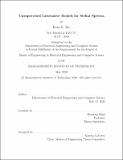| dc.contributor.advisor | Devavrat Shah. | en_US |
| dc.contributor.author | Tey, Evan S. | en_US |
| dc.contributor.other | Massachusetts Institute of Technology. Department of Electrical Engineering and Computer Science. | en_US |
| dc.date.accessioned | 2020-09-15T22:02:25Z | |
| dc.date.available | 2020-09-15T22:02:25Z | |
| dc.date.copyright | 2020 | en_US |
| dc.date.issued | 2020 | en_US |
| dc.identifier.uri | https://hdl.handle.net/1721.1/127532 | |
| dc.description | Thesis: M. Eng., Massachusetts Institute of Technology, Department of Electrical Engineering and Computer Science, May, 2020 | en_US |
| dc.description | Cataloged from the official PDF of thesis. | en_US |
| dc.description | Includes bibliographical references (pages 59-60). | en_US |
| dc.description.abstract | Stellar spectra are created by complex physical processes that depend on underlying properties of a star. Past analyses have tried to understand them through careful hand-guided feature extraction or simulation fitting, but there are still discrepancies, for example, in the inferred chemical abundances of stars. In this work, we explore the use of unsupervised generative models for modeling stellar spectra. Specifically, we use a variational autoencoder (VAE) and a flow-based network called Glow to model simulated spectra. We find that both models are able to capture the overall structure of spectra in a condensed latent representation, however, VAEs are unable to accurately recreate the height and widths of absorption peaks in spectra. Glow, on the other hand, provides a promising latent variable landscape that does contain this information. We also demonstrate with Glow an automated peak-removal procedure through latent space exploration that is a first step towards integration with practical spectroscopic analyses. | en_US |
| dc.description.statementofresponsibility | by Evan S. Tey. | en_US |
| dc.format.extent | 60 pages | en_US |
| dc.language.iso | eng | en_US |
| dc.publisher | Massachusetts Institute of Technology | en_US |
| dc.rights | MIT theses may be protected by copyright. Please reuse MIT thesis content according to the MIT Libraries Permissions Policy, which is available through the URL provided. | en_US |
| dc.rights.uri | http://dspace.mit.edu/handle/1721.1/7582 | en_US |
| dc.subject | Electrical Engineering and Computer Science. | en_US |
| dc.title | Unsupervised generative models for stellar spectra | en_US |
| dc.type | Thesis | en_US |
| dc.description.degree | M. Eng. | en_US |
| dc.contributor.department | Massachusetts Institute of Technology. Department of Electrical Engineering and Computer Science | en_US |
| dc.identifier.oclc | 1193030930 | en_US |
| dc.description.collection | M.Eng. Massachusetts Institute of Technology, Department of Electrical Engineering and Computer Science | en_US |
| dspace.imported | 2020-09-15T22:02:25Z | en_US |
| mit.thesis.degree | Master | en_US |
| mit.thesis.department | EECS | en_US |
